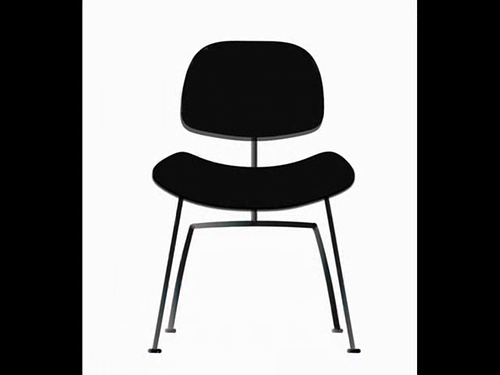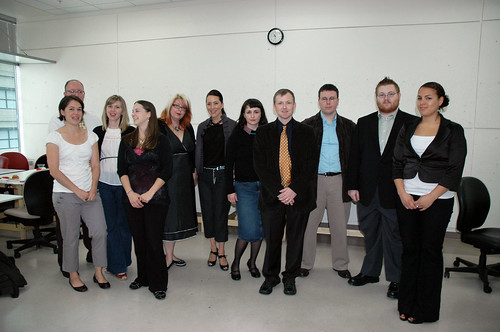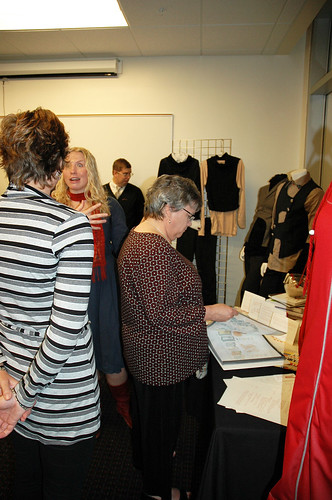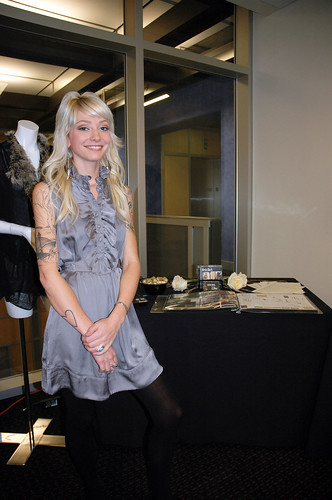semae = eames
Image by eyewashdesign: A. Golden
modern furniture series: semae sticker / tee logo / card, des. #3
the semae represents the Eames Low Side Chair by Charles and Ray Eames, 1946
It is hard to imagine now, but the use of plywood and chrome-plated steel in residential furniture was considered edgy, risky, and thoroughly new when this chair made its 1946 debut. It is modern, lightweight, strong, sculptural, and a complete departure from what furniture was.
Charles Ormond Eames, Jr was born in 1907 in Saint Louis, Missouri. By the time he was 14 years old, while attending high school, Charles worked at the Laclede Steel Company as a part-time laborer, where he learned about engineering, drawing, and architecture (and also first entertained the idea of one day becoming an architect).
Charles briefly studied architecture at Washington University in St. Louis on an architectural scholarship. He proposed studying Frank Lloyd Wright to his professors, and when he would not cease his interest in modern architects, he was dismissed from the university. In the report describing why he was dismissed from the university, a professor wrote the comment "His views were too modern." While at Washington University, he met his first wife, Catherine Woermann, whom he married in 1929. A year later, they had a daughter, Lucia.
After he left school and was married, Charles began his own architectural practice, with partners Charles Gray and later Walter Pauley.
One great influence on him was the Finnish architect Eliel Saarinen (whose son Eero, also an architect, would become a partner and friend). At the elder Saarinen's invitation, he moved in 1938 with his wife Catherine and daughter Lucia to Michigan, to further study architecture at the Cranbrook Academy of Art, where he would become a teacher and head of the industrial design department. One of the requirements of the Architecture and Urban Planning Program, at the time Eames applied, was for the student to have decided upon his project and gathered as much pertinent information in advance – Eames' interest was in the St. Louis waterfront. Together with Eero Saarinen he designed prize-winning furniture for New York's Museum of Modern Art "Organic Design" competition. Their work displayed the new technique of wood moulding (originally developed by Alvar Aalto), that Eames would further develop in many moulded plywood products, including, beside chairs and other furniture, splints and stretchers for the U.S. Navy during World War II.
In 1941, Charles and Catherine divorced, and he married his Cranbrook colleague Ray Kaiser, who was born in Sacramento, California. He then moved with her to Los Angeles, California, where they would work and live for the rest of their lives. In the late 1940s, as part of the Arts & Architecture magazine "Case Study" program, Ray and Charles designed and built the groundbreaking Eames House, Case Study House #8, as their home. Located upon a cliff overlooking the Pacific Ocean, and constructed entirely of pre-fabricated steel parts intended for industrial construction, it remains a milestone of modern architecture.
In the 1950s, the Eameses would continue their work in architecture and modern furniture design, often (like in the earlier moulded plywood work) pioneering innovative technologies, such as the fiberglass and plastic resin chairs and the wire mesh chairs designed for Herman Miller. Besides this work, Charles would soon channel his interest in photography into the production of short films. From their first one, the unfinished Traveling Boy (1950), to the extraordinary Powers of Ten (1977), their cinematic work was an outlet for ideas, a vehicle for experimentation and education.
The Eameses also conceived and designed a number of landmark exhibitions. The first of these, Mathematica: a world of numbers...and beyond (1961), was sponsored by IBM, and is the only one of their exhibitions still existant. The original was created for a new wing of the (currently named) California Science Center; it is now owned by and on display at the New York Hall of Science. In late 1961 a duplicate was created for the Museum of Science and Industry in Chicago; in 1980 it moved to the Museum of Science, Boston. Another version was created for the 1964/1965 New York World's Fair IBM exhibit. After the World's Fair it was moved to the Pacific Science Center in Seattle where it stayed until 1980. The Mathematica Exhibition is still considered a model for scientific popularization exhibitions. It was followed by "A Computer Perspective: Background to the Computer Age" (1971) and "The World of Franklin and Jefferson" (1975-1977), among others.
The office of Charles and Ray Eames, which functioned for more than four decades (1943-88) at 901 Washington Boulevard in Venice, California, included in its staff, at one time of another, a number of remarkable designers, like Don Albinson, Deborah Sussman, Richard Foy and Henry Beer.
Among the many important designs originating there are the molded-plywood DCW (Dining Chair Wood) and DCM (Dining Chair Metal with a plywood seat) (1945), Eames Lounge Chair (1956), the Aluminum Group furniture (1958) and as well as the Eames Chaise (1968), designed for Charles's friend, film director Billy Wilder, the playful Do-Nothing Machine (1957), an early solar energy experiment, and a number of toys.
Short films produced by the couple often document their interests in collecting toys and cultural artifacts on their travels. The films also record the process of hanging their exhibits or producing classic furniture designs, to the purposefully mundane topic of filming soap suds moving over the pavement of a parking lot. Perhaps their most popular movie, "Powers of 10", gives a dramatic demonstration of orders of magnitude by visually zooming away from the earth to the edge of the universe, and then microscopically zooming into the nucleus of a carbon atom. Charles was a prolific photographer as well with thousands of images of their furniture, exhibits and collections, and now a part of the Library of Congress.
Charles Eames died of a heart attack on August 21, 1978 while on a consulting trip in his native Saint Louis, and now has a star on the St. Louis Walk of Fame. Ray died 10 years later to the exact day.
At the time of his death they were working on what became their last production, the Eames Sofa which went into production in 1984.
graphics: a.golden, eyewash design c. 2007
Arne Jaconben:
The Model 3107 chair is one of the most popular chairs in Danish design history. It was designed by Arne Jacobsen, using a new technique in which plywood could be bent in two dimensions. It has been produced exclusively by Fritz Hansen A/S ever since its invention in 1955. It is also the most copied chair in the world.
Being a "copy" itself contributes some irony to that fact. The chair, along with the Jacobsen's Ant chair, was, according to Jacobsen himself, inspired by a chair made by the husband and wife design team of Charles and Ray Eames.
The chair comes with a number of different undercarriges - both as a regular four-legged chair, an office-chair with five wheels and as a barstool. It comes with armrests, a writing-table attached, and different forms of upholstring. To some extent, these additions mar the simple aesthetics of the chair, while contributing with some practical elements.
Arne Jacobsen is the Danish architect who mastered the most personal and successful interpretation of the international functionalism. His architecture includes a considerable number of epoch-making buildings in Denmark, Germany and Great Britain. Arne Jacobsen initially trained as a mason before studying architecture at the Royal Danish Academy of Arts, Copenhagen, graduating in 1927.
From 1927 until 1930, he worked in the architectural office of Paul Holsoe. In 1930, he established his own design office, which he headed until his death in 1971, and worked independently as an architect, interior, furniture, textile and ceramics designer. He was professor of Architecture at the Royal Academy of Arts, Copenhagen, from 1956 onwards. His best known projects are St. Catherine's College, Oxford, and the SAS Hotel, Copenhagen.
Arne Jacobsen's designs came into existence as brief sketches and were then modeled in plaster or cardboard in full size. He kept on working until his revolutionary ideas for new furniture had been realized at the utmost perfection. The "Ant" from 1952 became the starting point of his world fame as a furniture designer and became the first of a number of lightweight chairs with seat and back in one piece of moulded wood.
graphics: a.golden, eyewash design c. 2007
Art Institute of Portland Portfolio Show Summer 2008
Image by Art Institute of Portland
The Art Institute of Portland's Portfolio Show - graduating students in the fields of Advertising, Design Management, Design Studies, Design Visualization, Graphic Design, Industrial Design, Interior Design, Apparel Accessory Design, Apparel Design, Fashion Marketing, Digital Film and Video, Game Art and Design, Media Arts and Animation, Visual Effects and Motion Graphics, Visual and Game Programming, Web Design and Interactive Media show their portfolios to potential employers and the local business community.
Find out more about The Art Institute of Portland: www.artinstitutes.edu/portland
Photo: Lulu Hoeller
Art Institute of Portland Portfolio Show Summer 2008
Image by Art Institute of Portland
The Art Institute of Portland's Portfolio Show - graduating students in the fields of Advertising, Design Management, Design Studies, Design Visualization, Graphic Design, Industrial Design, Interior Design, Apparel Accessory Design, Apparel Design, Fashion Marketing, Digital Film and Video, Game Art and Design, Media Arts and Animation, Visual Effects and Motion Graphics, Visual and Game Programming, Web Design and Interactive Media show their portfolios to potential employers and the local business community.
Find out more about The Art Institute of Portland: www.artinstitutes.edu/portland
Photo: Lulu Hoeller
Art Institute of Portland Portfolio Show Summer 2008
Image by Art Institute of Portland
The Art Institute of Portland's Portfolio Show - graduating students in the fields of Advertising, Design Management, Design Studies, Design Visualization, Graphic Design, Industrial Design, Interior Design, Apparel Accessory Design, Apparel Design, Fashion Marketing, Digital Film and Video, Game Art and Design, Media Arts and Animation, Visual Effects and Motion Graphics, Visual and Game Programming, Web Design and Interactive Media show their portfolios to potential employers and the local business community.
Find out more about The Art Institute of Portland: www.artinstitutes.edu/portland
Photo: Lulu Hoeller
Art Institute of Portland Portfolio Show Summer 2008
Image by Art Institute of Portland
The Art Institute of Portland's Portfolio Show - graduating students in the fields of Advertising, Design Management, Design Studies, Design Visualization, Graphic Design, Industrial Design, Interior Design, Apparel Accessory Design, Apparel Design, Fashion Marketing, Digital Film and Video, Game Art and Design, Media Arts and Animation, Visual Effects and Motion Graphics, Visual and Game Programming, Web Design and Interactive Media show their portfolios to potential employers and the local business community.
Find out more about The Art Institute of Portland: www.artinstitutes.edu/portland
Photo: Lulu Hoeller
No comments:
Post a Comment